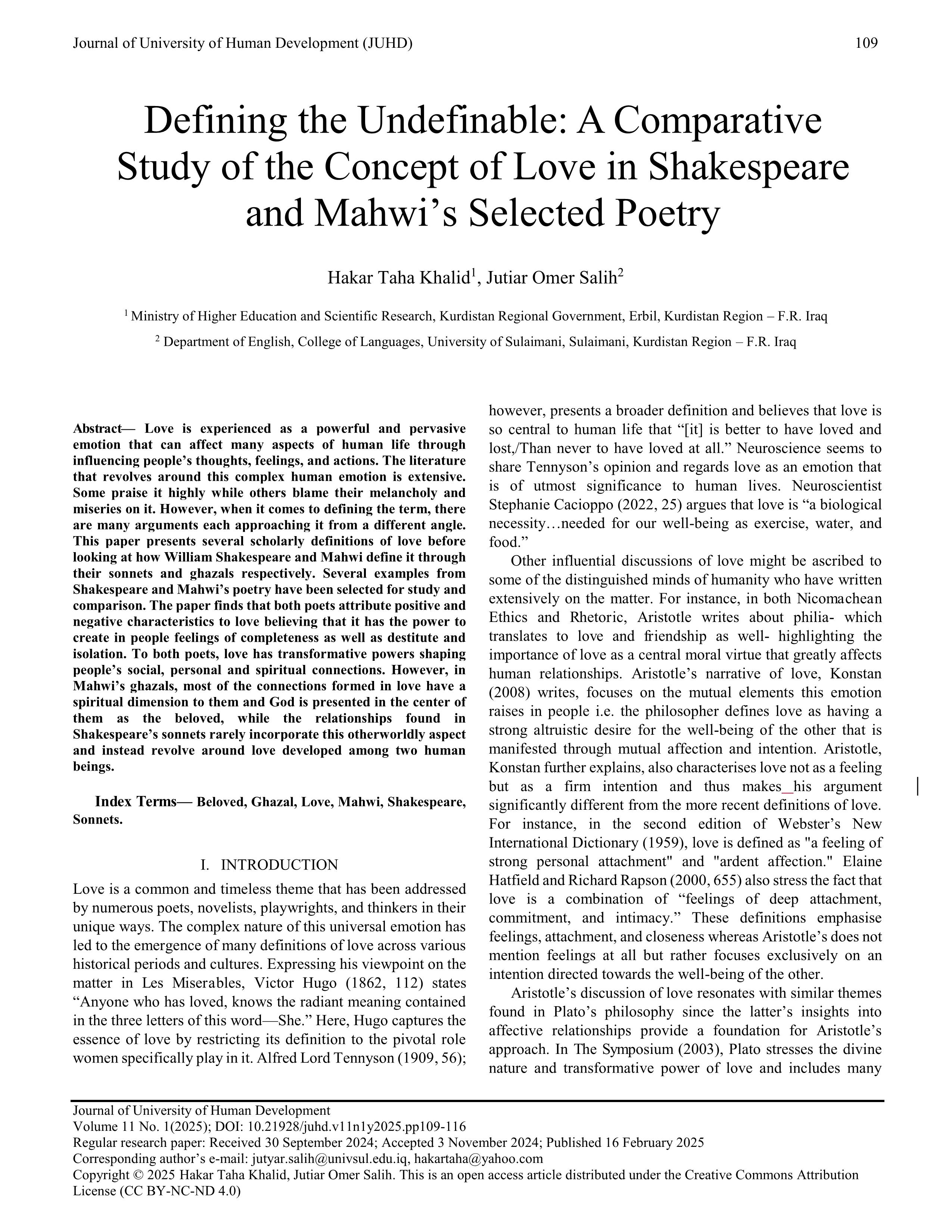Defining the Undefinable: A Comparative Study of the Concept of Love in Shakespeare and Mahwi’s Selected Poetry
DOI:
https://doi.org/10.21928/juhd.v11n1y2025.pp109-116Keywords:
Beloved, Ghazal, Mahwi, Shakespeare, SonnetsAbstract
Love is experienced as a powerful and pervasive emotion that can affect many aspects of human life through influencing people’s thoughts, feelings, and actions. The literature that revolves around this complex human emotion is extensive. Some praise it highly while others blame their melancholy and miseries on it. However, when it comes to defining the term, there are many arguments each approaching it from a different angle. This paper presents several scholarly definitions of love before looking at how William Shakespeare and Mahwi define it through their sonnets and ghazals respectively. Several examples from Shakespeare and Mahwi’s poetry have been selected for study and comparison. The paper finds that both poets attribute positive and negative characteristics to love believing that it has the power to create in people feelings of completeness as well as destitute and isolation. To both poets, love has transformative powers shaping people’s social, personal and spiritual connections. However, in Mahwi’s ghazals, most of the connections formed in love have a spiritual dimension to them and God is presented in the center of them as the beloved, while the relationships found in Shakespeare’s sonnets rarely incorporate this otherworldly aspect and instead revolve around love developed among two human beings.
References
Ambardekar, R. R. (1978). Bhavabhuti's concept of love. Indian Literature, 21(3), 78-87.
Amin, N. M. (2019). Picking flowers along the way: The second generation of the Baban school of poets (Vol. 1, Book 3). Zheen.
Baldwin, J. (1998). In search of a majority: An address. In Collected Essays. The Library of America.
Barnstorff, D. (1862). A Key to Shakespeare's sonnets (T. J. Graham, Trans.). Trubner and Co.
Cacioppo, S. (2022). Wired for love: A neuroscientist's journey through romance, loss, and the essence of human connection. Flatiron Books.
Callaghan, D. (2007). Shakespeare's sonnets. Blackwell Publishing.
Combellack, C. R. B. (1982). Shakespeare's sonnet 116. Explicator, 41(1), 12-14.
Cuddon, J. A. (2013). A dictionary of literary terms and literary theory. Wiley-Blackwell, 668.
Garrigues, G. (1887). Shakespeare's sonnets. The Journal of Speculative Philosophy, 21(3), 241-258. https://doi.org/10.5840/specphil18872138
Ghaderi, F. (2016). The emergence and development of modern Kurdish poetry (Doctoral dissertation, University of Exeter). Open Research Exeter (ORE). http://hdl.handle.net/10871/22267
Hart, J. (2009). Shakespeare: poetry, history, and culture. Palgrave Macmillan.
Hatfield, E., & Rapson, R. L. (2000). Love and attachment process. In M. Lewis & J. M. Haviland-Jones (Eds.), Handbook of Emotions (2nd ed., pp. 654–662). New York: Guilford Press.
Hugo, V. (1862). Les Misérables (O. E. Wilbour, Trans.). Carleton.
Hussein, H. A. (2012). Ghazal in modern Kurdish literature. The Journal of Zankoy Sulaimani - Part B, 34(March), 141-180.
Khalifa, M. J. (2017). An apology for Persian ghazal as a verse form: A study of selected ghazals of Agha Shahid Ali’s Call me Ishmael tonight. Annals of the Faculty of Arts, Ain Shams University, 45(January - March B), 380-405. https://doi.org/10.21608/aafu.2017.16438
Khaznadar, M. (2004). The history of Kurdish literature: The second half of 19th century and beginning of 20th century 1851 - 1914 (Vol. IV). Aras Publishers.
Konstan, David. Aristotle on love and friendship. ΣΧΟΛΗ Vol. II. 2 (2008), pp. 207-212.
Krasnowolska, A. (2006). The epic roots of lyrical imagery in classical Persian poetry. In Ghazal as world literature II (1st ed., Vol. 4, pp. 109–120). Ergon. Istanbuler Texte und Studien (ITS).
Mahwi. (1984). Mahwi’s Diwan (M. A. Mudaris & M. M. Kareem, Eds.). Hussam Publishing House.
McRae, W. (1987). Shakespeare's sonnet 29. Explicator, 46(1), 6-8.
Neilson, W. A. (1959). Webster's new international dictionary of the English language (2nd ed., unabridged). G & C Merriam Co.
Plato. (2003). The Symposium (B. Jowett, Trans.). Dover Publications.
Pritchett, F. W. (2015). Literature and love. Manoa, 27(1), 220–225.
Prus, R., & Camara, F. (2010). Love, friendship, and disaffection in Plato and Aristotle: Toward a pragmatist analysis of interpersonal relationships. Qualitative Sociology Review, 6(3), 29-62.
Roessner, J. (1982). The coherence and the context of Shakespeare’s Sonnet 116. The Journal of English and Germanic Philology, 81(3), 331–346.
Salem Press, & Shakespeare, W. (2014). Critical survey of Shakespeare's sonnets (1st ed.). Grey House Publishing; Salem Press, a division of EBSCO Information Services.
Sarkar, M. (1998). The magic of Shakespeare's sonnets. Renaissance Studies, 12(2), 251-260. https://doi.org/10.1111/1467-9655.00112
Sarker, S. K. (1998). Shakespeare's sonnets. Atlantic Publishers & Distributors (P) Limited.
Shakespeare, W. (2004). Sonnet 116. In J. Jowett (Ed.), The complete works of William Shakespeare (pp. 123-124). Oxford University Press.
Spiller, M. R. G. (1992). The development of the sonnet. Routledge.
Tennyson, A. L. (1909). In memoriam. G. P. Putnam’s Sons.
The Qur'an. (2004). The Qur'an (M. A. S. Abdel Haleem, Trans.). Oxford University Press.
Zand, S. J. A. (2020). Centralizing the concepts of “maashoq” and “the other” in the worldview of Mahwi and Emmanuel Levinas. Twejer, 3(3), 129-168. https://doi.org/10.31918/twejer.2033.4

Downloads
Published
How to Cite
Issue
Section
License
Copyright (c) 2025 Hakar Taha Khalid, Jutiar Omer Salih

This work is licensed under a Creative Commons Attribution-NonCommercial-NoDerivatives 4.0 International License.


